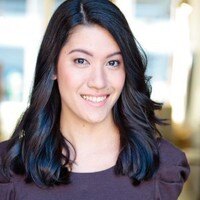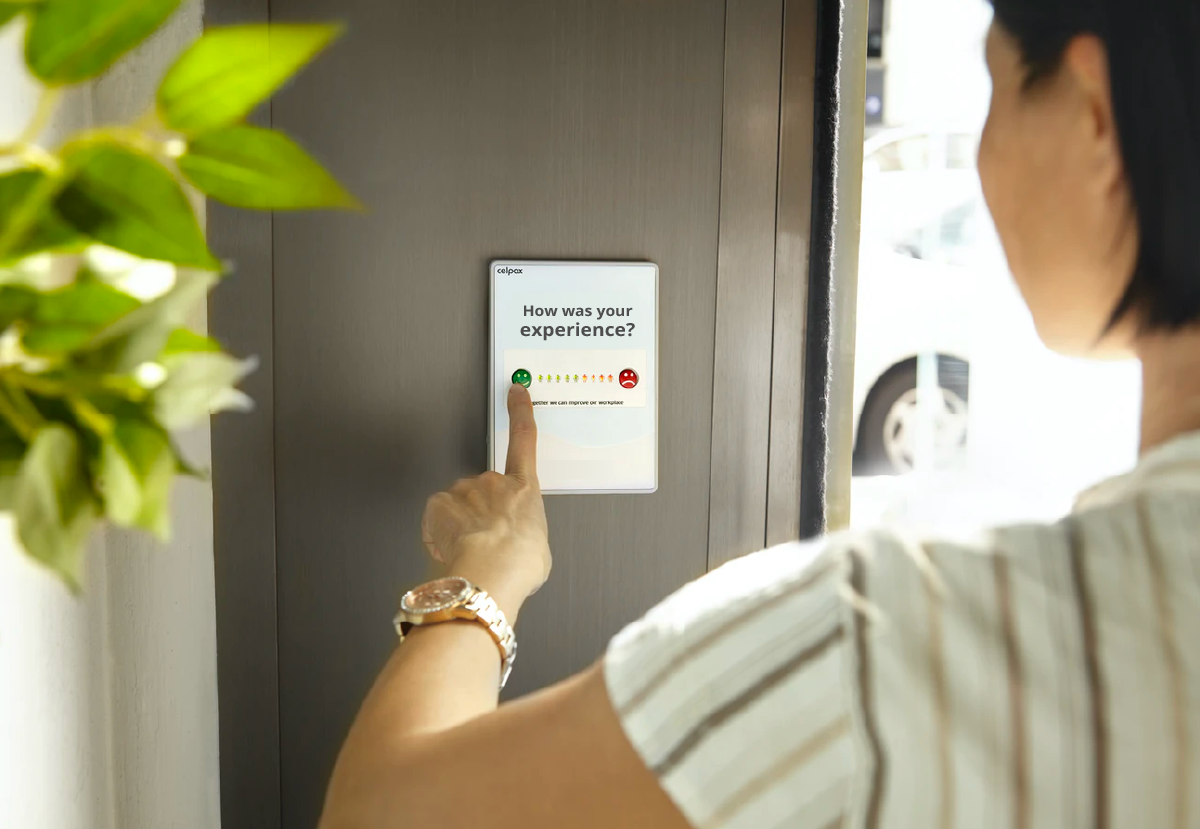
A Guide to Navigating Shopper Input
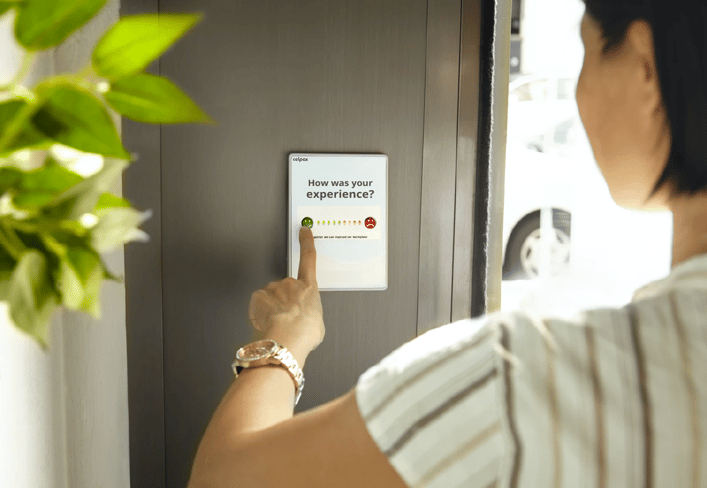
Did you know that poor customer experiences result in an estimated $83 billion loss by U.S. businesses every year?
Gathering, managing, and analyzing customer feedback is a vital part of your customer success strategy, but is often neglected by businesses. In fact, a recent study by Hubspot found that 42% of businesses don't collect customer feedback at all.
If you don't know what your customers think or want, it's impossible to put them at the center of your growth plan. That's why a robust customer feedback management strategy is the key to fostering lasting relationships with your customers.
In this post, we're going to:
- Discuss why customer feedback matters
- Identify key types of customer feedback
- Talk about how to collect, manage, and analyze customer feedback
Let’s dive in!
Why is it important to collect customer feedback?
Let’s kick things off by discussing the benefits of having good customer feedback management practices in place.
It helps to refine your product/service
Making the effort to collect customer feedback helps you to identify pain points, as well as gather suggestions that you can communicate to your customer success and product teams. In turn, this helps to enhance your product/service and promote a better user experience.
Essentially, any omnichannel retailer should be making the customer the focal point of their business, and collecting customer feedback will enable this process.
It improves customer satisfaction and retention
No matter what business you run, your customers want to feel as though their experiences matter. When customer service representatives take a long time to respond to concerns – or worse, don't respond at all – this can seriously damage the customer relationship.
On the flip side, when you make the effort to implement changes or updates on the back of feedback surveys, it showcases a customer-centric approach that aims to meet the expectations of loyal customers. And when customers are satisfied, your retention rates will soar.
It strengthens your WOM (Word of Mouth) marketing efforts
Here's a fact about marketing: We're far more likely to trust other people's perception of a business than what that business says about itself. In fact, 88% of consumers say that they trust online reviews just as much as personal recommendations.
With the rise of social media and community forums, we're no longer passive consumers of advertising. By making customer feedback a core functionality of your business model, you have a powerful customer acquisition strategy.
Types of customer feedback
Customer feedback can be divided into two main types: Direct/solicited customer feedback, and indirect/unsolicited customer feedback.
Direct/solicited customer feedback
This refers to feedback processes that rely on the business reaching out to their customers for feedback. The advantage of this approach is that businesses can either tailor their surveys to specific topics, such as the usability of certain features, or they can ask about the customer journey as a whole. However, invitations for direct feedback often struggle with low uptake.
Direct/solicited customer feedback methods include the following:
- Customer surveys
- Customer reviews
- Focus groups
Indirect/unsolicited customer feedback
Conversely, indirect/unsolicited feedback is when a customer reaches out to a business with queries or concerns. It's within a business's interest to encourage this behavior, as unsolicited feedback can often bring up issues or opportunities they wouldn't have identified on their own.
The following can be considered types of indirect/unsolicited feedback:
- Social media
- Customer support centers
- Live chat
Note: It's a good idea to use a combination of methods to ensure that your business is getting impartial feedback data. In this next section, we're going to dive into some of these methods in more depth.
How to collect customer feedback
Now let’s look at the different ways that you can gather feedback from shoppers.
Customer surveys
Customer surveys are one of the most common methods for feedback collection. You can completely customize a survey depending on what your needs are, making it one of the best options for collecting feedback on a large scale.
However, putting together a good feedback survey is a lot of work. Once you've chosen the area that you want feedback on, you need to decide what survey format is most appropriate.
While a qualitative survey using free text fields is one of the easiest to put together, it can be a discouraging time investment for customers, and setting it up effectively could be time-consuming for you too.
Instead, you could consider using some qualitative forms of customer satisfaction survey, such as:
Customer Satisfaction Score (CSAT)
CSAT is a metric for determining how satisfied your customers are with different touchpoints in the customer journey. It captures customer sentiment when they're interacting with that stage of your offering i.e. "How would you rate your recent order or experience?"
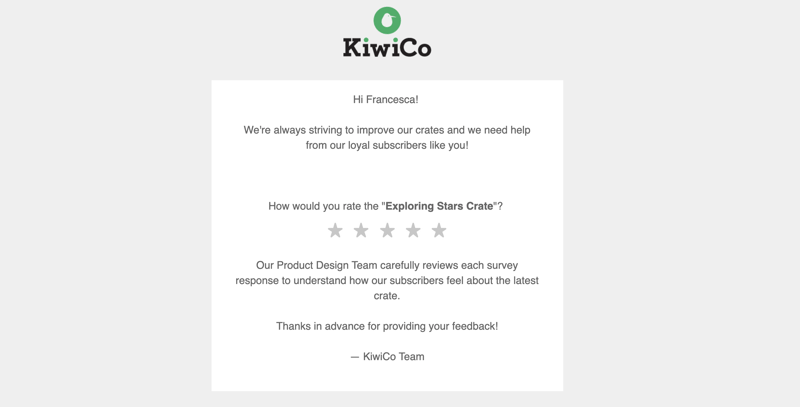
CSATs usually give customers the choice of choosing a number between 1 and 5, with 5 being “very satisfied” and 1 being “highly dissatisfied”. CSATs can be single questions or use several back-to-back questions depending on how broad you want your survey to be.
Net Promoter Score (NPS)
NPS is another qualitative survey measure but it differs from CSAT. NPS measures long-term customer loyalty. It helps to benchmark a customer's willingness to recommend/promote your brand to others, which indicates their commitment to repeat purchases. So, if your NPS is low, this means your churn rate is likely to be high.
Most NPS surveys use a 10-point scale, as shown in this template by Le Tote:
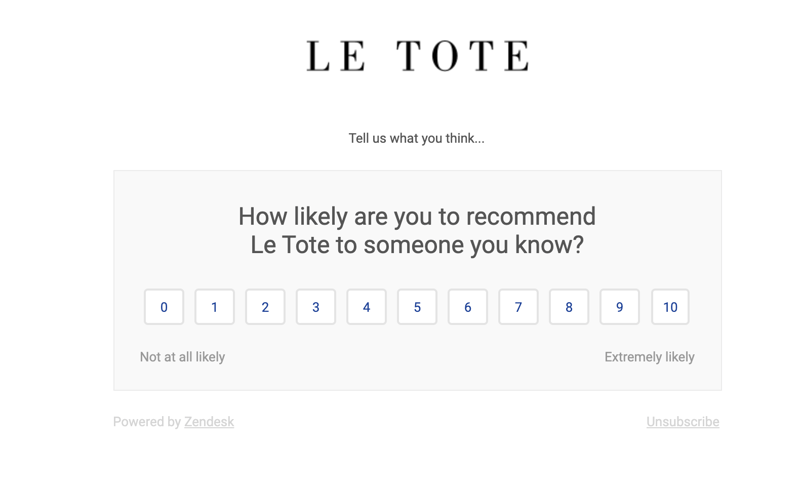
2-choice questions
In some cases, you want to make it as simple as possible for customers to provide feedback. This is why 2-choice surveys can be extremely useful when you want to gather a quick pulse from your customers.
The following example from Katie Waltman, which lets people indicate their feedback by simply tapping a happy or sad face is an example of quick and easy feedback collection.
And in case customers would like to share additional details, Katie Waltman asks a quick follow-up question based on the shoppers’ initial response. Katie Waltman has a 97% customer feedback rating. Their customers have particularly positive feedback for KW’s product quality, customer service, and the value of their products. Keeping in mind that customers are most inclined to leave feedback when they are passionate, this makes praise that Katie Waltman has received all the more impressive.
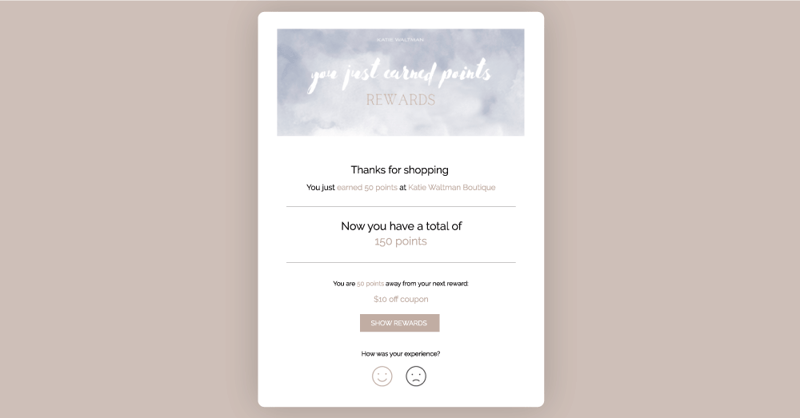
Social media monitoring
Did you know that 1 in 3 consumers would rather post service or product feedback on social media than contact a business directly? Quick and appropriate follow-ups to comments and mentions by your customers are vital on an open forum, and also presents opportunities to ask for feedback via polls and surveys:

Qualitative customer interviews
If you're wanting more in-depth customer insights, organizing a series of interviews with customers is a great tool for adding more context to NPS and CSAT surveys. Getting direct information straight from shoppers can help to highlight and create understanding around areas that are working well, versus areas of your business that could do with attention.
This technique is best suited for interviewing long-term customers who can answer more in-depth questions about your product/service. It's a good idea to use your CRM to pick out loyal customers who can offer you the most valuable insights.
How to manage customer feedback
Once you’ve collected a good amount of feedback, it’s best to set up processes for managing all that information so you can act on it.
Use the right CFM tools
Feedback management tools are vital to getting the most out of your feedback collection. CFM (customer feedback management) software allows you to sort and analyze customer data effectively, rather than having your customer success team spend days or even weeks sorting through it manually.
The right tools depend on how your business plans on gathering customer feedback. For example, if you plan on doing customer surveys on a regular basis, a survey tool like SurveyMonkey or Typeform is a good investment. Likewise, you're a brand with a large social media presence, consider a social listening tool such as Brand24 that uses AI to monitor brand reputation in real-time, a popular technique with SaaS companies.
On the other hand, if you want to grab quick feedback on the product or shopping experience of your customers, then an eCommerce CRM like Marsello is a great option. Marsello’s feedback tool makes it easy to attach quick surveys to your transactional emails so customers can let you know how they feel.
From there, you can get detailed reporting on customer satisfaction and find ways to improve.
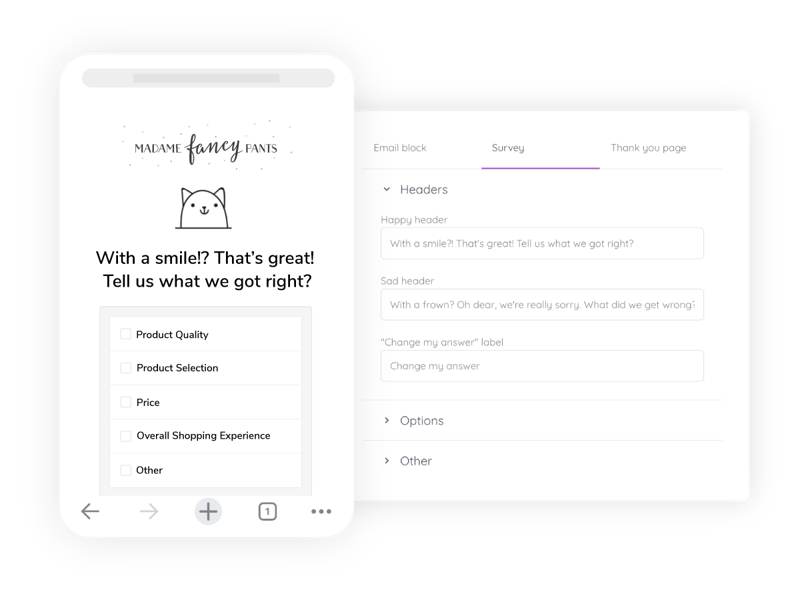
Implement a Voice of the Customer (VoC) program
The Voice of the Customer (VoC) is a broad term referring to all of the data and metrics you've gathered from feedback management tools and unsolicited customer feedback. A VoC program collates all this data from across channels to identify emerging themes that indicate specific pain points, then develops a roadmap to address them.
For a VoC program to work effectively, it can't be siloed just to your customer success division. It requires active collaboration with the product development, marketing, and sales teams to identify trends within their own workflows. For example, if the sales team keeps coming across a particular feature request, this can be passed onto the product team far more seamlessly.
Close the feedback loop
Once you've identified issues or opportunities and taken action in response, it's important not to miss out on informing customers what you've accomplished. This is known as “closing the feedback loop.”
Unless customers receive a follow-up, they have no idea whether their concerns have been listened to. This leaves the feedback loop wide open and could affect your retention efforts.
So, once you've decided to introduce a change in response to feedback, you need to think about the best way to communicate this. The appropriate channel will depend on the demographics of the respondents. For example, if your survey was hosted on social media, it makes sense to inform customers using the same medium. If it was an on-site survey, you could consider producing a webinar that discusses your initiatives.
How to analyze your customer feedback
The best way to get the most out of customer feedback is to analyze it. Here are some tips to help you organize what you’ve collected and ensured that you gain actionable insights from them.
Categorize your feedback types
Once your data is in one place, assigning it to a specific group will help you get a broad overview of what areas are receiving the most attention from your customers. For example, you could use categories like:
- Onboarding
- Pricing/billing
- Feature requests
- Product/user experience
- Technical support.
You can also break these down further into sub-categories i.e. whether the feedback is negative or positive.
This exercise will help you to highlight any overarching trends and “hidden” issues that your business might not have identified, such as confusing pricing structures or difficulty finding support documentation.
Start feedback analysis
While it's possible to analyze your feedback manually, this is a very time-consuming process and requires someone with strong expertise in coding and data analysis. Moreover, there's always the potential for personal bias to get in the way of finding actionable insights from your customers.
Instead, consider using a tool such as Marsello, which can organize feedback data into graphs and tables that make it easy to analyze the information.
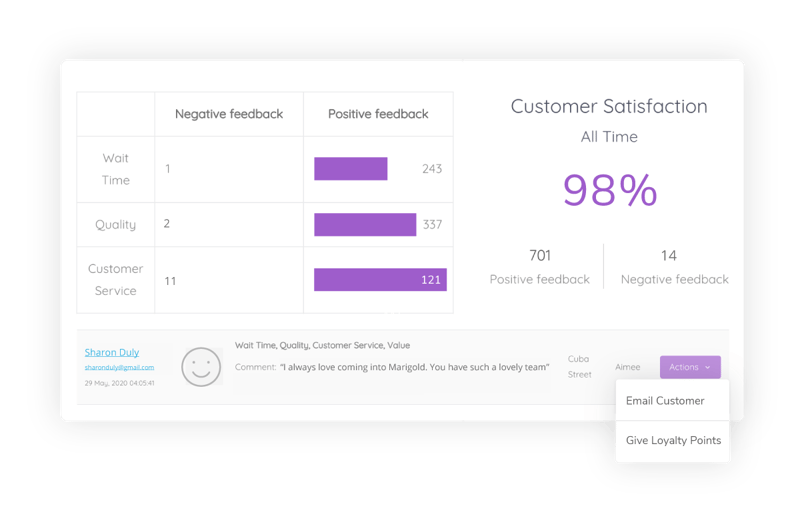 As patterns start emerging, it's important to ask yourself some key questions:
As patterns start emerging, it's important to ask yourself some key questions:
- Are these new or established customers?
- Where are they located?
- Who has been assigned to manage their account?
This helps to add context to the results of your analysis – and may also establish some underlying causes for recurring issues.
Present your results
Once you have the results of your customer feedback campaign, you need to think about the best way to present them to your teams. This will depend on whether you're doing a relatively focused feedback survey or a landmark study on your product/service as a whole.
If it's a small feedback project, you can likely present the results on a one-page that summarizes the key takeaways via bullet points or tables. In the case of large, multi-question studies, you will need to break this down in a lot more detail.
Large-scale data visualization using line or bar graphs are a great way to communicate to your staff the changes to customer sentiment over time and provide answers to key questions. Check out this visualization by Thematic investigating the reasons behind a drop in NPS:

Thematic not only displays the drop-in NPS rating over time but also offers the user detailed information that highlights why their performance could be taking a downward turn.
Final words
Customer feedback has traditionally been one of the most neglected elements in customer success. It's easy for businesses to tell themselves that gathering customer feedback is too time-consuming or difficult to analyze to be worth the effort.
But at the end of the day, customer satisfaction is the key to long-term success as a business. If your customers are unhappy with your service or product offering, your churn rate is going to skyrocket. But by implementing a strong customer feedback program, you're in a much better position to foster retention and loyalty.
Need to collect and analyze customer feedback? Marsello has powerful tools to help retailers gather input from shoppers and turn them into actionable insights.

